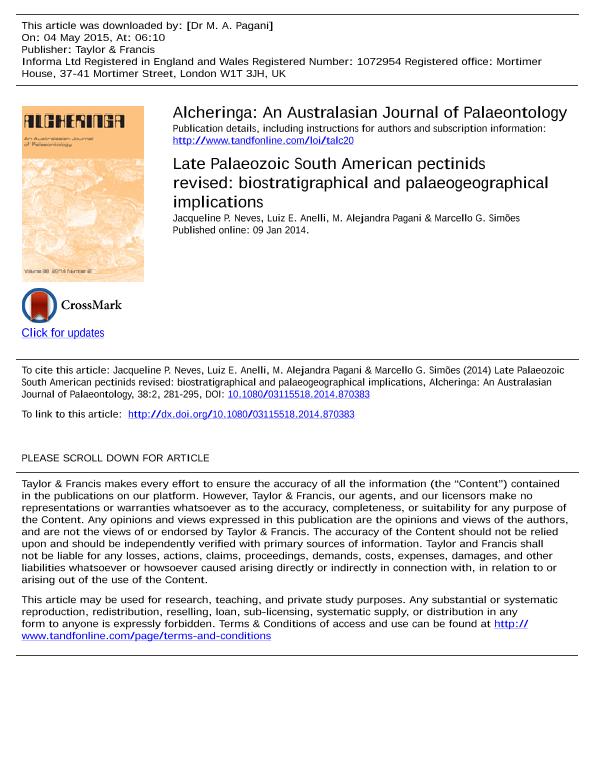Mostrar el registro sencillo del ítem
dc.contributor.author
Neves, Jacqueline P.
dc.contributor.author
Anelli, Luiz E.
dc.contributor.author
Pagani, María Alejandra

dc.contributor.author
Simões, Marcello
dc.date.available
2017-08-14T20:33:42Z
dc.date.issued
2014-01
dc.identifier.citation
Neves, Jacqueline P.; Anelli, Luiz E.; Pagani, María Alejandra; Simões, Marcello; Late Palaeozoic South American pectinids revised: biostratigraphical and palaeogeographical implications; Taylor & Francis; Alcheringa; 38; 2; 1-2014; 281-295
dc.identifier.issn
0311-5518
dc.identifier.uri
http://hdl.handle.net/11336/22374
dc.description.abstract
A revision of the late Palaeozoic South American pectinid Heteropecten multiscalptus (Thomas) and the establishment of Heteropecten paranaensis sp. nov. have important implications for the relationship between faunal realms within South America. Late Palaeozoic bivalve faunas occur in three distinct realms in South America: a Central Gondwanic Realm with endemic taxa showing affinities to Australia, New Zealand, South Africa and Namibia, a cold Perigondwanic Realm, and a warm Extragondwanic Realm with tethyan-like affinities similar to faunas of the American Midcontinent. In South America, faunas east of the southern Andes belong to the first two realms and previous interpretations of bivalve faunas suggested biocorrelations with those of the Extragondwanic Realm because they shared the taxon Heteropecten multiscalptus (Thomas). A revision of the Peruvian and Brazilian material does not confirm this. Instead, a re-analysis suggests that two species are present, rather than one: Heteropecten multiscalptus in the Cerro Prieto Formation, Amotape Mountains (Peru; Extragondwanic Realm), and Heteropecten paranaensis sp. nov. in the upper part of the Itararé Group, Paraná Basin (Brazil; Central Gondwanic Realm). Thus, the correlation between the late Palaeozoic faunas of the Central Gondwanic and Extragondwanic Realms in South America can no longer be supported. Heteropecten paranaensis sp. nov. lived in a siliciclastic-dominated, cold, epeiric sea of Brazil and Argentina, and is morphologically similar to some Australian species, whereas the Peruvian H. multiscalptus thrived in the warm seas of the Extragondwanic Realm.
dc.format
application/pdf
dc.language.iso
eng
dc.publisher
Taylor & Francis

dc.rights
info:eu-repo/semantics/openAccess
dc.rights.uri
https://creativecommons.org/licenses/by-nc-sa/2.5/ar/
dc.subject
Late Palaeozoic
dc.subject
Biostratigraphy
dc.subject
Palaeogeography
dc.subject
Pectinids
dc.subject
Bbivalve Molluscs
dc.subject
South America
dc.subject.classification
Oceanografía, Hidrología, Recursos Hídricos

dc.subject.classification
Ciencias de la Tierra y relacionadas con el Medio Ambiente

dc.subject.classification
CIENCIAS NATURALES Y EXACTAS

dc.title
Late Palaeozoic South American pectinids revised: biostratigraphical and palaeogeographical implications
dc.type
info:eu-repo/semantics/article
dc.type
info:ar-repo/semantics/artículo
dc.type
info:eu-repo/semantics/publishedVersion
dc.date.updated
2017-06-08T19:59:05Z
dc.journal.volume
38
dc.journal.number
2
dc.journal.pagination
281-295
dc.journal.pais
Reino Unido

dc.journal.ciudad
Londres
dc.description.fil
Fil: Neves, Jacqueline P.. Universidade Estadual Paulista Julio de Mesquita Filho; Brasil
dc.description.fil
Fil: Anelli, Luiz E.. Universidade de Sao Paulo; Brasil
dc.description.fil
Fil: Pagani, María Alejandra. Museo Paleontológico Egidio Feruglio; Argentina. Consejo Nacional de Investigaciones Científicas y Técnicas; Argentina
dc.description.fil
Fil: Simões, Marcello. Universidade Estadual Paulista Julio de Mesquita Filho; Brasil
dc.journal.title
Alcheringa

dc.relation.alternativeid
info:eu-repo/semantics/altIdentifier/doi/http://dx.doi.org/10.1080/03115518.2014.870383
dc.relation.alternativeid
info:eu-repo/semantics/altIdentifier/url/http://www.tandfonline.com/doi/abs/10.1080/03115518.2014.870383
Archivos asociados
